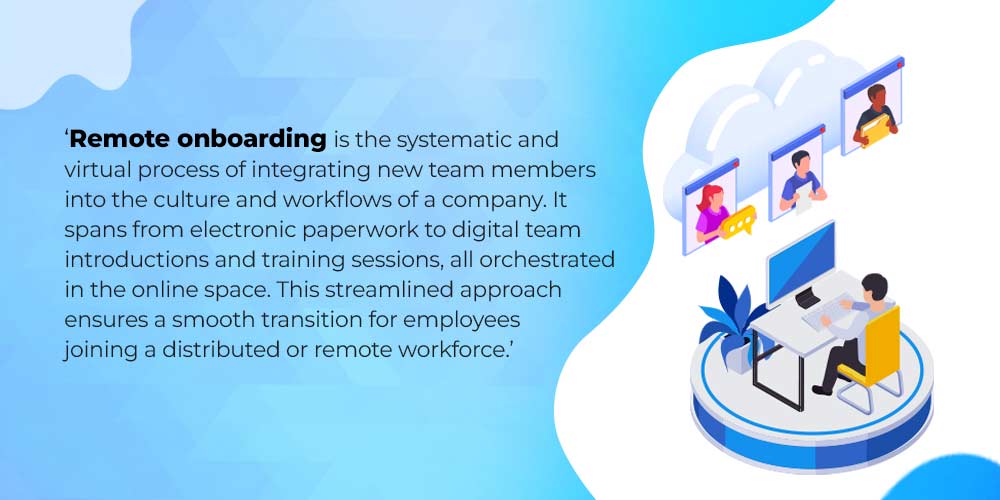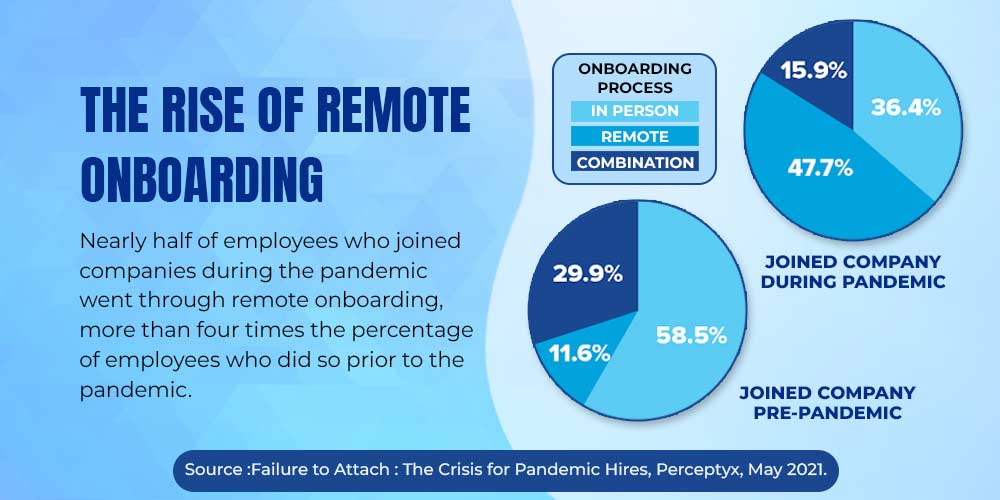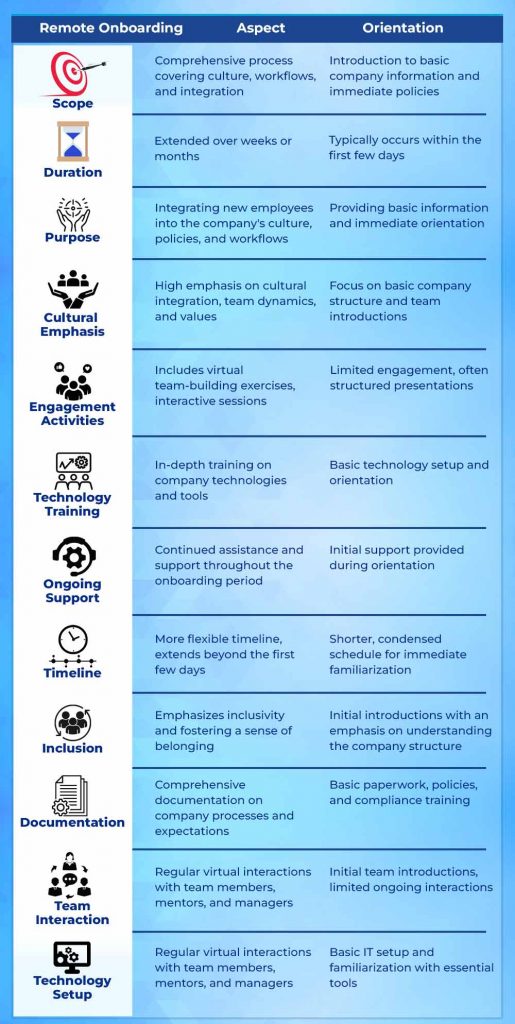Remote Onboarding Adventure: Your Guide to a Seamless Start
Recall the excitement of your first in-person job – the fresh outfit, paperwork in hand, and nerves electrifying the air. A warm welcome from your manager, an IT wizard setting up your desk, and meeting more people than you could high-five, remote onboarding takes a different route from in-person onboarding, as you effortlessly transition to your “office” – be it a designated desk or the comfort of your kitchen table. Armed with home-brewed coffee and your trusty computer, you’re poised to plunge into the digital unknown.
What now?
Get ready to find out in this remote onboarding adventure as we unveil the secrets, challenges, and triumphs of remote onboarding.
It’s the digital odyssey you never knew you needed.


The Imperative of Remote Onboarding in Today’s Digital Landscape


- Rise of Remote Work:
Remote work has seen a significant surge. By 2024, experts predict that 25-30% of the U.S. workforce will be working remotely multiple days a week, according to Upwork’s “Future of Workforce Pulse Report.” Remote onboarding becomes crucial as more companies adopt or continue remote work models, ensuring a seamless entry for new team members.
- Global Talent Pool:
The shift to remote work allows companies to tap into a global talent pool. Remote onboarding facilitates the integration of diverse talent, contributing to a more inclusive and globally representative workforce.
- Employee Satisfaction:
Remote work can positively impact employee satisfaction. Buffer’s 2023 State of Remote Work report found that 91 percent of survey respondents enjoyed working remotely, with flexibility listed as the biggest benefit. Effective remote onboarding contributes to job satisfaction by creating a positive first impression and fostering a sense of belonging.
- Productivity Gains:
Remote work is associated with productivity gains. Prodoscore reported a 47% increase in average productivity for remote workers during the COVID-19 pandemic. Properly onboarded remote employees are more likely to contribute to these productivity gains by quickly adapting to their roles and responsibilities.
- Cost Savings for Companies:
Remote work can lead to cost savings for companies. According to Global Workplace Analytics, nearly 60 percent of employers identify cost savings as a significant telecommuting benefit. It estimates that for all remote-work-compatible jobs if everyone who wanted to work remotely did so just half of the time, the total money saved would be over $700 billion annually. This averages out to more than $11,000 per employee per year. Streamlined remote onboarding directly translates to significant cost savings. This includes a reduction in expenses tied to office space, utilities, and on-site orientation.
- Technology’s Role:
Technology plays a pivotal role in remote work success. Remote onboarding leverages technology to facilitate seamless communication, collaboration, and training for new hires, ensuring they are well-equipped for the digital workplace.
Some of the technological advancements that are making remote work possible include:
- Cloud computing: Cloud computing allows employees to access work files and applications from anywhere in the world with an internet connection.
- Video conferencing: Video conferencing tools like Zoom and Microsoft Teams make it easy for employees to collaborate face-to-face, even when they are not in the same location.
- Project management tools: Project management tools like Jira and Trello help employees stay organized and on track, even when they are working from different locations.
These advancements have made it possible for companies to operate successfully with a remote workforce.
Remote Onboarding Prowess: Companies Setting the Bar High
In today’s landscape, marked by a fundamental shift to remote work, onboarding remotely is pivotal. It serves as the cornerstone for successful team integration, heightened employee satisfaction, and enhanced organizational efficiency.


Companies who perfected remote onboarding processes:
- GitLab, a global leader in the software development industry, has an entirely remote workforce. They have a comprehensive onboarding process that includes detailed documentation, virtual coffee chats, and buddy assignments to help new hires acclimate to the remote work culture.
- Zapier, a company specializing in automation tools, is known for its fully remote team. They prioritize asynchronous communication and have a well-structured onboarding process. New hires go through a series of video calls, training sessions, and collaborative projects to get acquainted with the company’s processes.
- Automattic (WordPress), the company behind WordPress.com, is a distributed company with employees working from various locations. They have a detailed onboarding program that includes a month-long orientation, mentorship, and frequent virtual meetups to help new hires feel connected and integrated into the company culture.
- Buffer, a social media management platform, is renowned for its transparent company culture and remote-friendly policies. Their onboarding process involves virtual team-building activities, one-on-one video calls, and a focus on individualized training plans to ensure new hires feel supported.
- InVision, a digital product design platform, has a robust onboarding program designed for remote work. They provide new hires with a comprehensive toolkit, conduct virtual orientation sessions, and facilitate team introductions through video calls, creating a sense of connection and belonging.
- Doist, the company behind productivity tools like Todoist and Twist, operates as a remote-first company. Their onboarding process includes a combination of asynchronous communication, virtual team-building activities, and an emphasis on clear documentation to help new hires quickly adapt to the remote work environment.
- Twilio, a cloud communications platform, has adapted its onboarding process to suit a remote work environment. Employing virtual training sessions, mentorship programs, and collaborative projects, they seamlessly integrate new hires into their teams. This approach emphasizes the importance of clear communication channels throughout the onboarding process.
- Basecamp, a project management and team collaboration platform, has a dispersed team and a strong remote work culture. Their onboarding process involves a combination of asynchronous communication tools, video calls, and a focus on cultivating a supportive and inclusive work environment.
- Stack Overflow, a community-driven platform for developers, has a remote-friendly work culture. every new hire has orientation calls with each member of the executive team to learn about the company’s history, culture, goals, and structure.
- Chargify, a subscription billing platform, is 100% remote and uses some of the office budgetary savings to equip new hires with the best tools and technology. They incorporate virtual training, one-on-one sessions, and collaborative projects to ensure new hires swiftly acclimate to their roles and the company culture.
- Boldly, a pioneer in remote staffing solutions has innovatively crafted a ‘Digital Vault.’ This repository seamlessly integrates onboarding videos, guides, a knowledge base, company news, video updates, and team insights. This resource empowers new employees to acquaint themselves at their own pace with a wealth of information readily available.
- Kin HR, a human resources management platform, utilizes its app which has a dedicated onboarding feature where a personalized journey is created for each new joiner.
These companies showcase diverse approaches to remote onboarding, highlighting the flexibility and creativity needed to create a successful virtual integration process for new team members.
Navigating Challenges with a Splash of Solutions
Ahoy, fellow captains of the corporate seas!
As we collectively chart the course through the uncharted waters of remote onboarding, it’s crucial to acknowledge the tempestuous challenges that come with the territory.
Picture this: a transition from the firm handshakes of boardrooms to the solitary splendor of home desks. The absence of in-person camaraderie, the potential tech squalls, and the perennial query, “Am we doing this right?” echoing in the virtual abyss.
But fret not, savvy navigators! Every challenge is but a wave to ride. From the lack of face-to-face camaraderie to the virtual void staring back at you, we’re here to infuse your onboarding journey with solutions as bright as the North Star.
So, hoist the sails, and tighten those digital knots!
Challenge 1: Limited Face-to-Face Interaction
Solution 1: Virtual Coffee Chats and Welcome Meetings
- Host weekly or bi-weekly virtual coffee breaks for casual conversations.
- Conduct a welcome meeting on the first day, introducing new hires to team members.
Solution 2: Interactive Icebreaker Activities
- Incorporate fun, icebreaker questions in team meetings or onboarding sessions.
- Use online collaboration tools for interactive games to break the ice.
Challenge 2: Access to Resources and Information
Solution: Centralized Digital Onboarding Platform
- Develop a user-friendly portal with easy navigation.
- Include guides, documents, and links to relevant tools on the platform.
- Ensure new hires have access to the platform before their start date.
Challenge 3: Building Team Culture Remotely
Solution 1: Virtual Team-Building Activities
- Establish a routine of regular team-building sessions, incorporating activities like virtual escape rooms or online games.
- Foster informal discussions during virtual breaks to emulate the casual ambiance of water cooler conversations.
Solution 2: Informal Communication Channels
- Create dedicated channels on messaging platforms for casual conversations.
- Encourage team members to share personal updates, creating a sense of community.
Challenge 4: Limited Personal Connection
Solution: Virtual Mentorship Programs
- Pair new hires with experienced team members as mentors.
- Schedule regular virtual check-ins between mentors and mentees.
Challenge 5: Technology Onboarding
Solution: Pre-Onboarding Tech Setup
- Provide a pre-onboarding tech checklist with instructions.
- Offer tech support sessions for new hires to address any issues.
These actionable solutions address the core challenges of remote onboarding, promoting a smooth transition for new hires and fostering a positive and inclusive team culture in a virtual environment.
FAQs from the Remote Crew:
FAQ 1: How do we make new hires feel connected?
Answer: Hoist the virtual flag with regular check-ins, team-building quests, and mentorship programs. To delve deeper into enhancing your remote onboarding experience for employees, feel free to explore the guide here.
FAQ 2: What tools are essential for remote onboarding?
Answer: Equip your crew with video conferencing tools, collaboration platforms, and HR software.
Tools for Remote Buccaneers
- Jira, the Task Treasure Map: Learn how to organize onboarding tasks and discover hidden gems in your workflow.
- Slack Channels, the Digital Spyglass: Peer through the digital spyglass of Slack channels, creating dedicated spaces for onboarding topics. Explore how to foster collaboration and communication within your crew.
- GreytHR, the HR Compass: A compass that streamlines onboarding processes. Discover how to make your HR processes seamless and efficient.
- Google MEET: Peer through the virtual telescope for video conferencing and navigating virtual meetings.
FAQ 3: How do we navigate time zone challenges?
Answer: Chart a course with flexible onboarding sessions and recorded materials for those in different time zones.
Flexible Onboarding Sessions
- Offer multiple onboarding sessions at different times.
- Record onboarding sessions for those who cannot attend live.
Time-Overlap Strategies
- Use time zone scheduling tools to find common working hours.
- Prioritize collaborative sessions and introductions during overlapping hours.
FAQ 3: Difference between Onboarding and Orientation?


Towards The Remote Onboarding Excellence
A good thing the pandemic left us with was the art of remote working. Today, many companies work remotely first or entirely remotely. Embracing the digital onboarding experience is not just a choice; it’s a strategic imperative for companies navigating the evolving work landscape.
Remember that this isn’t about you or your company. This process aims to make new employees feel welcome and included in the company. To ensure that your remote employees embody the fundamental values you promote, it is essential to customize their remote work experience.
Hence,
- Set sail on the seas of feedback! Learn from your crew and adapt accordingly.
- Regularly update your maps and processes to stay ahead of the ever-changing tides of remote work.
Embark on this epic remote onboarding adventure and let the winds of success fill your sails. Navigate the challenges, discover the benefits, and become the master of the remote seas!
Aye, aye, Captain!







